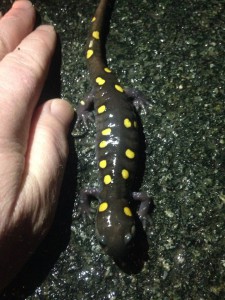Salamander Migration in Central New Jersey
By Charlene Smith, Program Coordinator

The temperatures might not be what they should be for this time of year but don’t tell that to the salamanders and frogs that are beginning their migrations to their natal vernal pools to reproduce. I went out on a cold, dark, rainy evening to the town of East Brunswick to be a part of this magical experience.
Every year around mid to late March into early April, these little creatures get ready to begin their annual journey to their breeding pools. Usually the temperatures need to be above 40 degrees Fahrenheit, and on this night activity was a little slow going until the rains came. Vernal pools are an important part of salamander and frog reproduction as they provide the perfect hatchery to lay eggs in shallow water undisturbed by predatory fish. David Moskowitz leads the effort to safely monitor the amphibian migrations with Friends of East Brunswick Environmental Commission, a not-for-profit which provides many earth friendly programs throughout the year. The study area, Beekman Road, is a long winding country road surrounded by woods that runs between the amphibians’ upland habitat and their breeding grounds. The road is closed, thanks to the work of the East Brunswick Environmental Commission, on nights when the migration might occur, allowing the animals to cross the road safely and preventing roadkills. David explained that most of East Brunswick used to be covered by vernal pools, but since development has occurred, the land around Beekman Road is one of the last wildlife refuges in the area so it warrants protection.

All the conditions have to be right for these amphibian migrations, and it seems that tonight is going to a “big night” as families with flashlights in hand gather on Beekman Road by the bunches. David’s enthusiasm is contagious, as he runs around the woods like a little kid, turning over logs to look for spotted salamanders, explaining to onlookers about their biology, diet, and breeding. He leads us on a trail marked with pink flags to the vernal pool to listen to spring peepers calling in the night. At this vernal pool, you will also find Northern gray treefrogs, wood frogs, chorus frogs, and other frog, toad, and salamander species. As the rain begins to get heavier, I begin to notice more spotted
salamanders crossing the road and I save one from being crushed. This leads me to think about CWF’s Amphibian Crossing Project led by Mackenzie Hall, Private Lands Biologist, and I know she must be out in the Northwestern part of the state, doing exactly the same thing, helping these small, yet incredibly important animals, survive in our ever more developed world.
Discover more from Conserve Wildlife Foundation of NJ
Subscribe to get the latest posts sent to your email.